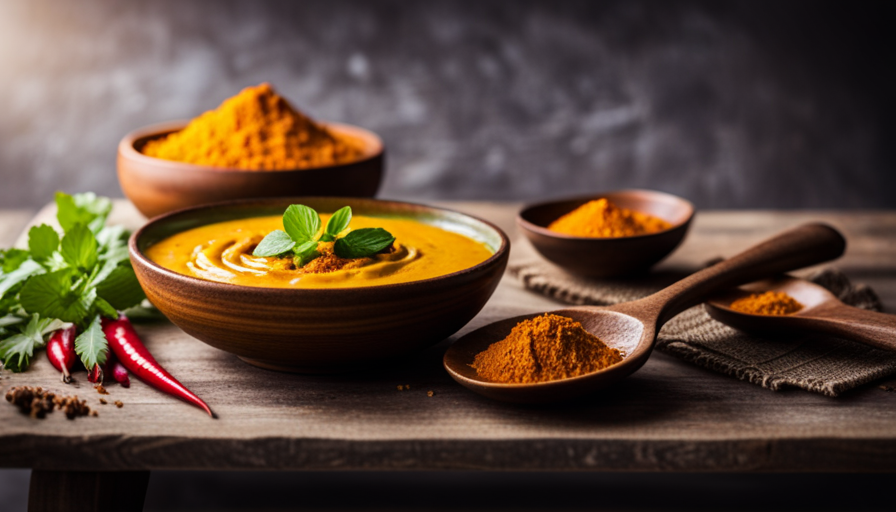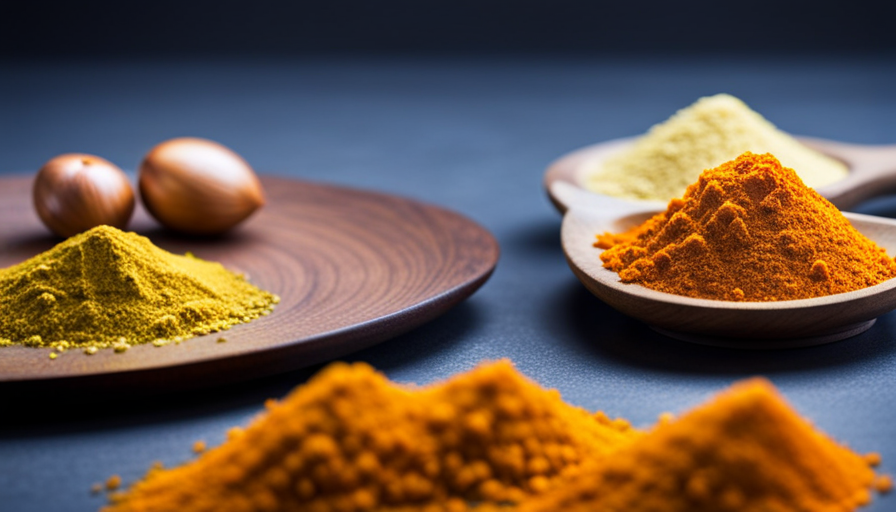While browsing the shelves at my nearby grocery store, I came across the bright orange tones of turmeric, placed among the various spices. This sparked some thoughts in my mind: “Is turmeric suitable for a low FODMAP diet? Can it provide a flavorful kick without leading to digestive issues?” These inquiries are frequently pondered by individuals following a low FODMAP regimen, designed to minimize the consumption of specific carbohydrates that may provoke digestive discomfort.
As a registered dietitian, I understand the importance of providing accurate and evidence-based information to empower individuals in making informed dietary choices. In this article, we will explore the properties of turmeric, its FODMAP content, and the research surrounding its effects on digestive sensitivities. We will also provide tips on incorporating turmeric into a low FODMAP diet, along with alternative spices and seasonings for flavorful cooking.
So, let’s dive into the world of turmeric and discover if it’s truly ‘okay’ on a low FODMAP diet.
Key Takeaways
- Turmeric is low in FODMAPs and can be incorporated into a low FODMAP diet in moderation.
- Turmeric supplements should be checked for high FODMAP additives.
- Turmeric contains curcumin, which has anti-inflammatory and antioxidant properties that may help alleviate symptoms of digestive disorders like IBS.
- Cooking methods and preparation techniques can affect the FODMAP content of turmeric dishes.
Understanding the Low FODMAP Diet
If you’re curious about the low FODMAP diet, you’re in for a treat because we’re about to dive into all the juicy details! As a registered dietitian, I’ve got a strong understanding of nutrition science and the effects of different foods on the body.
The low FODMAP diet is a scientifically-backed approach to managing symptoms of irritable bowel syndrome (IBS) by eliminating certain types of carbohydrates that can trigger digestive issues.
The goal of the low FODMAP diet is to reduce the intake of fermentable carbohydrates that can be poorly absorbed in the small intestine, leading to symptoms such as bloating, gas, abdominal pain, and diarrhea. By understanding FODMAPs, which stands for Fermentable Oligosaccharides, Disaccharides, Monosaccharides, and Polyols, individuals can tailor their diets to minimize these symptoms.
Managing FODMAP symptoms requires a two-step process: elimination and reintroduction. During the elimination phase, high FODMAP foods are avoided for a specified period, typically two to six weeks. This allows the gut to settle and symptoms to improve. Following the elimination phase, foods are systematically reintroduced to determine which specific FODMAPs trigger symptoms in each individual.
Now that we’ve got a solid understanding of FODMAP elimination and managing symptoms, let’s explore the properties of turmeric and its potential role in a low FODMAP diet.
Exploring the Properties of Turmeric
You may be surprised to learn that there’s a fascinating research finding that highlights the potential benefits of incorporating a certain spice into your diet. Turmeric, a vibrant yellow spice commonly used in Indian cuisine, has been the subject of numerous studies exploring its health benefits.
Curcumin, the active compound in turmeric, has been found to possess anti-inflammatory and antioxidant properties, which may contribute to its potential health benefits.
While turmeric can be consumed in its natural form, many individuals opt for turmeric supplements for convenience. These supplements often contain higher concentrations of curcumin, which may provide a more potent effect. However, it’s important to note that the effectiveness of turmeric supplements can vary depending on factors such as the quality of the supplement and individual differences in absorption.
Incorporating turmeric into your low FODMAP diet can be a great way to add flavor and potential health benefits to your meals. However, it’s important to be mindful of the FODMAP content in turmeric, as some individuals with sensitive digestive systems may experience symptoms such as bloating or gas.
In the next section, we’ll explore the FODMAP content in turmeric and provide guidance on incorporating it into a low FODMAP diet.
FODMAP Content in Turmeric
One thing to keep in mind is that turmeric may affect individuals with sensitive digestive systems, potentially causing symptoms like bloating or gas. For those following a low FODMAP diet, it is important to understand the FODMAP content in turmeric. FODMAPs are a group of carbohydrates that can trigger digestive symptoms in some people, especially those with irritable bowel syndrome (IBS). While turmeric itself is low in FODMAPs, some commercially available turmeric supplements may contain high FODMAP ingredients like fructans or oligosaccharides. Therefore, it is crucial to check the labels of turmeric supplements for any potential high FODMAP additives.
To provide a clearer picture, here is a table outlining the FODMAP content of turmeric:
| FODMAP Type | FODMAP Content in Turmeric |
|---|---|
| Fructans | Low |
| Oligosaccharides | Low |
| Disaccharides | Low |
| Monosaccharides | Low |
| Polyols | Low |
Despite potential digestive sensitivities, turmeric has been widely recognized for its health benefits. It contains a compound called curcumin, which has anti-inflammatory and antioxidant properties. Research suggests that curcumin may help reduce inflammation, improve digestion, and support gut health. However, more studies are needed to fully understand the effects of turmeric on digestive sensitivities. Transitioning into the next section, let’s explore the research on turmeric and its potential impact on individuals with sensitive digestive systems.
Research on Turmeric and Digestive Sensitivities
Despite its potential to cause digestive discomfort, turmeric has been the subject of research exploring its effects on individuals with sensitive stomachs. Research findings suggest that turmeric may actually provide several benefits for digestive health.
For example, a study published in the Journal of Medicinal Food found that curcumin, the active compound in turmeric, exhibits anti-inflammatory and antioxidant properties that may help alleviate symptoms of digestive disorders such as irritable bowel syndrome (IBS).
Another study published in the Journal of Gastroenterology and Hepatology observed that curcumin supplementation reduced abdominal pain and improved overall quality of life in individuals with IBS.
Additionally, curcumin has been shown to enhance digestive enzyme production and stimulate bile flow, which can aid in the digestion and absorption of nutrients.
These research findings suggest that incorporating turmeric into a low FODMAP diet may be beneficial for individuals with digestive sensitivities. However, it’s important to note that individual responses to turmeric may vary, and it’s recommended to consult with a healthcare professional before making any dietary changes.
Factors to Consider when Incorporating Turmeric into a Low FODMAP Diet
When incorporating turmeric into a low FODMAP diet, it’s important to consider portion size and moderation. While turmeric is generally considered safe in small amounts, consuming large quantities may have a negative impact on individuals with digestive sensitivities.
Additionally, the cooking methods and preparation techniques used can affect the FODMAP content of turmeric-containing dishes, so it’s essential to choose cooking methods that minimize the release of FODMAPs.
By being mindful of portion sizes and cooking methods, individuals can enjoy the benefits of turmeric while still adhering to their low FODMAP diet.
Portion size and moderation
To ensure you enjoy the benefits of turmeric while following a low FODMAP diet, it’s essential to be mindful of your portion sizes and practice moderation. While turmeric is generally well-tolerated, consuming large amounts may lead to potential side effects such as digestive discomfort or an upset stomach. To help you understand how much turmeric is appropriate for your low FODMAP diet, here is a handy portion control guide:
| Portion Size | Turmeric Amount |
|---|---|
| Small | ¼ teaspoon |
| Medium | ½ teaspoon |
| Large | ¾ teaspoon |
| Extra Large | 1 teaspoon |
By following these portion sizes, you can enjoy the flavor and health benefits of turmeric without exceeding your recommended intake. Transitioning to the next section, let’s explore different cooking methods and preparation techniques for incorporating turmeric into your low FODMAP meals.
Cooking methods and preparation techniques
When it comes to cooking with turmeric on a low FODMAP diet, it’s important to consider the cooking methods and preparation techniques used. Turmeric is a versatile spice that can be used in various ways, such as in curries, stir-fries, and even in smoothies.
Cooking methods like sautéing or simmering turmeric in oil can help enhance its flavor and increase its bioavailability. Additionally, pairing turmeric with black pepper can further enhance its health benefits due to the presence of piperine, a compound that improves turmeric’s absorption.
It’s worth noting that while turmeric itself is low FODMAP, some store-bought curry powders or spice blends containing turmeric may contain high FODMAP ingredients such as onion or garlic powder. Thus, it’s always best to check the ingredient list or make your own spice blends.
Now, let’s explore some alternative spices and seasonings for low FODMAP cooking.
Alternative Spices and Seasonings for Low FODMAP Cooking
When following a low FODMAP diet, it’s important to find flavorful alternatives for spices and seasonings that may trigger digestive symptoms. Fortunately, there are plenty of FODMAP-friendly options available.
Some popular choices include ginger, cumin, and cinnamon. These spices can add depth and complexity to your dishes without causing discomfort.
Additionally, if you’re looking for a substitute for turmeric, consider using saffron or paprika. These alternatives can add color and flavor to your meals while staying within the guidelines of your low FODMAP diet.
FODMAP-friendly spices and herbs
Using FODMAP-friendly spices and herbs can add lots of flavor to your meals while keeping your tummy happy! When following a low FODMAP diet, it’s important to choose seasonings that won’t trigger digestive symptoms. Luckily, there are plenty of options available that are safe to use. Here are five FODMAP-friendly seasoning options to consider:
- Basil: This herb adds a fresh and aromatic flavor to dishes without causing any digestive issues.
- Cumin: Known for its earthy and warm taste, cumin is a great option to enhance the flavor of your meals.
- Coriander: With a citrusy and slightly sweet flavor, coriander adds a unique twist to your low FODMAP dishes.
- Dill: This herb offers a refreshing and tangy taste that pairs well with fish, salads, and dips.
- Oregano: Known for its robust flavor, oregano is a versatile spice that can be used in a variety of dishes.
While turmeric is not low FODMAP, there are plenty of flavorful substitutes available that can be used in your cooking. Let’s explore some tasty alternatives to turmeric in the next section.
Flavorful substitutes for turmeric
Now that we’ve explored FODMAP-friendly spices and herbs, let’s talk about flavorful substitutes for turmeric. While turmeric isn’t recommended on a low FODMAP diet due to its high FODMAP content, there are plenty of other herbs and spices that can provide similar health benefits and add a burst of flavor to your meals.
One great option is ginger, which has anti-inflammatory properties and a warm, spicy taste. Cumin is another fantastic alternative, offering a smoky, earthy flavor and aiding digestion. Additionally, paprika can provide a vibrant color and a mild, slightly sweet flavor.
By incorporating these flavorful alternatives into your cooking, you can still enjoy delicious meals while adhering to a low FODMAP diet.
And speaking of turmeric, let’s explore some tips for incorporating it into a low FODMAP diet.
Tips for Incorporating Turmeric into a Low FODMAP Diet
To add a burst of flavor and warmth to your low FODMAP diet, embrace the golden power of turmeric, and let its vibrant hues ignite your taste buds with a fiery passion.
Here are some tips for incorporating turmeric into a low FODMAP diet:
-
Incorporate turmeric into smoothies: Add a teaspoon of ground turmeric to your favorite low FODMAP smoothie recipe for a delicious and nutritious boost. Turmeric pairs well with fruits like pineapple and banana, as well as almond milk or lactose-free yogurt.
-
Create turmeric-infused oils and dressings: Make your own turmeric-infused oil by heating a neutral oil like olive oil with a teaspoon of turmeric powder. Use this flavorful oil to dress salads or drizzle over cooked vegetables. You can also mix turmeric with low FODMAP ingredients like lemon juice and olive oil to create a tangy turmeric dressing.
-
Experiment with turmeric in savory dishes: Turmeric adds depth and complexity to savory dishes. Try adding it to low FODMAP soups, stews, or curries for a delightful flavor boost. Pair it with other low FODMAP herbs and spices like cumin, coriander, and ginger for a well-rounded taste.
Incorporating turmeric into your low FODMAP diet can be an exciting way to enhance your meals and reap the potential health benefits of this vibrant spice. Stay tuned for recipes and meal ideas for low FODMAP turmeric dishes.
Recipes and Meal Ideas for Low FODMAP Turmeric Dishes
Embrace the vibrant power of turmeric in your meals with these delicious recipes and meal ideas for adding a burst of flavor and warmth to your low FODMAP diet. Turmeric, with its vibrant yellow color and earthy flavor, is a versatile spice that can be incorporated into a variety of dishes. Not only does turmeric add a delicious taste to your meals, but it also offers a range of health benefits. Curcumin, the active compound in turmeric, has been shown to have anti-inflammatory and antioxidant properties, which can support digestive health and reduce inflammation in the body.
To help you get started, here are some low FODMAP turmeric recipes and meal ideas:
| Recipe | Meal Idea |
|---|---|
| Turmeric Chicken Curry | Serve with rice and steamed vegetables |
| Turmeric Roasted Vegetables | Toss with olive oil and roast in the oven |
| Turmeric Quinoa Salad | Mix cooked quinoa with turmeric, cucumber, and lemon juice |
| Turmeric Ginger Smoothie | Blend turmeric, ginger, banana, spinach, and almond milk |
| Turmeric Golden Milk | Heat almond milk with turmeric, ginger, and a touch of maple syrup |
These recipes and meal ideas not only taste delicious but also ensure that you are getting the benefits of turmeric while following a low FODMAP diet. Remember to always check the ingredients of any store-bought products you use to ensure they are low FODMAP. So, let’s explore the world of turmeric-infused dishes and enjoy the benefits it brings to our digestive well-being.
Other Considerations for Digestive Well-being
For optimal digestive well-being, it’s important to consider various factors beyond incorporating turmeric into your meals.
Taking digestive supplements can provide additional support for gut health. Probiotics, for example, can help balance the beneficial bacteria in the gut, promoting proper digestion and reducing symptoms such as bloating and gas. Digestive enzymes are another option; they can assist in breaking down carbohydrates, proteins, and fats, improving nutrient absorption and reducing digestive discomfort.
In addition to supplements, lifestyle factors play a crucial role in digestive health. Managing stress levels is important, as stress can disrupt digestion and exacerbate symptoms. Engaging in regular physical activity can also support a healthy digestive system by stimulating bowel movements and promoting overall gut motility.
Furthermore, it’s essential to stay hydrated and consume an adequate amount of fiber-rich foods. Drinking enough water helps prevent constipation and keeps the digestive system running smoothly. Fiber, found in fruits, vegetables, and whole grains, adds bulk to the stool and promotes regularity.
By considering these factors alongside incorporating turmeric into your low FODMAP meals, you can support your digestive well-being and optimize gut health. As always, it’s recommended to consult with a registered dietitian or nutritionist for personalized guidance and to ensure you’re meeting your specific dietary needs.
Frequently Asked Questions
Can turmeric be consumed on a low FODMAP diet?
Turmeric is a great spice to incorporate into a low FODMAP diet. It’s been shown to have numerous benefits for gut health. Turmeric contains a compound called curcumin, which has anti-inflammatory properties and may help reduce symptoms of digestive disorders. Including turmeric in your meals can add flavor and provide potential health benefits.
However, it’s important to note that individual tolerances may vary, so it’s best to consult with a healthcare professional or registered dietitian for personalized guidance.
What are the potential digestive benefits of turmeric?
Turmeric, with its vibrant golden hue, offers potential digestive benefits. Studies suggest that its active compound, curcumin, may reduce inflammation in the gut and alleviate symptoms of conditions like irritable bowel syndrome. Incorporating turmeric into your diet through flavorful recipes, such as turmeric-spiced roasted vegetables or a warming turmeric latte, can be a delicious way to reap these potential health benefits.
However, for individuals following a low FODMAP diet, it’s important to consume turmeric in moderation to avoid triggering symptoms.
Does turmeric contain any FODMAPs?
Turmeric doesn’t contain any FODMAPs, so it’s suitable for those on a low FODMAP diet. It also has potential digestive health benefits, thanks to its anti-inflammatory properties. This means it may help reduce symptoms of digestive disorders like irritable bowel syndrome. Adding turmeric to your diet can be a tasty way to support your digestive system while following a low FODMAP eating plan.
Is there any research on the effects of turmeric on digestive sensitivities?
There is limited research on the effects of turmeric on digestive sensitivities. However, studies have shown that turmeric has anti-inflammatory properties, which may have a positive impact on gut health. Turmeric contains a compound called curcumin, which has been shown to reduce inflammation in the body. While more research is needed, incorporating turmeric into a low FODMAP diet may be beneficial for those with digestive sensitivities.
Are there any alternative spices or seasonings that can be used in low FODMAP cooking?
When it comes to low FODMAP cooking, there are plenty of alternative seasonings and spices substitutes that are FODMAP friendly. Some great options include herbs like basil, oregano, and thyme, as well as spices like cumin, paprika, and cinnamon. These seasonings can add flavor to your dishes without causing digestive sensitivities.
It’s important to remember that everyone’s tolerance to different foods may vary, so it’s best to experiment and find what works best for you.
Conclusion
In conclusion, incorporating turmeric into a low FODMAP diet can be a beneficial choice for individuals with digestive sensitivities. While turmeric contains some FODMAPs, the overall content is considered low and can be tolerated by most people following the diet. Research suggests that turmeric may have anti-inflammatory and digestive benefits, making it a valuable addition to a low FODMAP eating plan. However, it’s important to consider individual tolerance and consult with a healthcare professional or registered dietitian before making any significant dietary changes. By exploring alternative spices and seasonings and following tips for incorporating turmeric, individuals can enjoy flavorful and nutritious low FODMAP meals. Remember to always prioritize digestive well-being and listen to your body’s needs.










